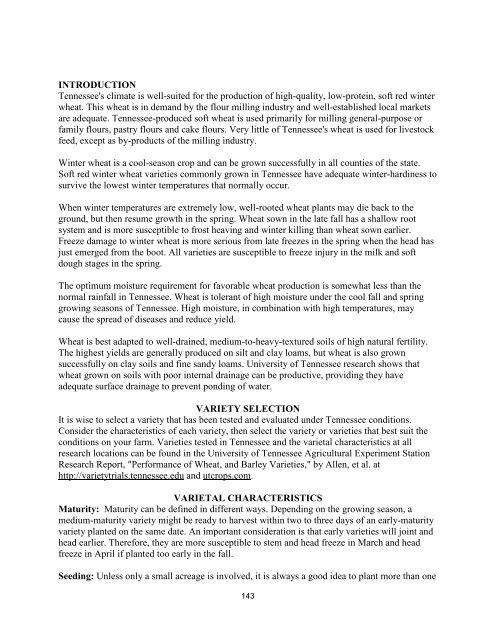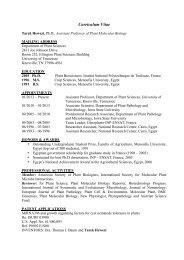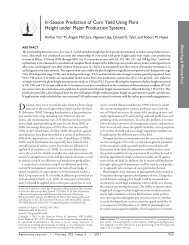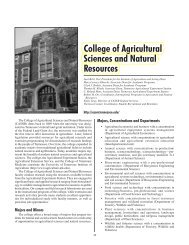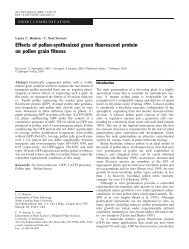CATEGORIES OF FORAGE CROPS - Department of Plant Sciences
CATEGORIES OF FORAGE CROPS - Department of Plant Sciences
CATEGORIES OF FORAGE CROPS - Department of Plant Sciences
You also want an ePaper? Increase the reach of your titles
YUMPU automatically turns print PDFs into web optimized ePapers that Google loves.
INTRODUCTION<br />
Tennessee's climate is well-suited for the production <strong>of</strong> high-quality, low-protein, s<strong>of</strong>t red winter<br />
wheat. This wheat is in demand by the flour milling industry and well-established local markets<br />
are adequate. Tennessee-produced s<strong>of</strong>t wheat is used primarily for milling general-purpose or<br />
family flours, pastry flours and cake flours. Very little <strong>of</strong> Tennessee's wheat is used for livestock<br />
feed, except as by-products <strong>of</strong> the milling industry.<br />
Winter wheat is a cool-season crop and can be grown successfully in all counties <strong>of</strong> the state.<br />
S<strong>of</strong>t red winter wheat varieties commonly grown in Tennessee have adequate winter-hardiness to<br />
survive the lowest winter temperatures that normally occur.<br />
When winter temperatures are extremely low, well-rooted wheat plants may die back to the<br />
ground, but then resume growth in the spring. Wheat sown in the late fall has a shallow root<br />
system and is more susceptible to frost heaving and winter killing than wheat sown earlier.<br />
Freeze damage to winter wheat is more serious from late freezes in the spring when the head has<br />
just emerged from the boot. All varieties are susceptible to freeze injury in the milk and s<strong>of</strong>t<br />
dough stages in the spring.<br />
The optimum moisture requirement for favorable wheat production is somewhat less than the<br />
normal rainfall in Tennessee. Wheat is tolerant <strong>of</strong> high moisture under the cool fall and spring<br />
growing seasons <strong>of</strong> Tennessee. High moisture, in combination with high temperatures, may<br />
cause the spread <strong>of</strong> diseases and reduce yield.<br />
Wheat is best adapted to well-drained, medium-to-heavy-textured soils <strong>of</strong> high natural fertility.<br />
The highest yields are generally produced on silt and clay loams, but wheat is also grown<br />
successfully on clay soils and fine sandy loams. University <strong>of</strong> Tennessee research shows that<br />
wheat grown on soils with poor internal drainage can be productive, providing they have<br />
adequate surface drainage to prevent ponding <strong>of</strong> water.<br />
VARIETY SELECTION<br />
It is wise to select a variety that has been tested and evaluated under Tennessee conditions.<br />
Consider the characteristics <strong>of</strong> each variety, then select the variety or varieties that best suit the<br />
conditions on your farm. Varieties tested in Tennessee and the varietal characteristics at all<br />
research locations can be found in the University <strong>of</strong> Tennessee Agricultural Experiment Station<br />
Research Report, "Performance <strong>of</strong> Wheat, and Barley Varieties," by Allen, et al. at<br />
http://varietytrials.tennessee.edu and utcrops.com.<br />
VARIETAL CHARACTERISTICS<br />
Maturity: Maturity can be defined in different ways. Depending on the growing season, a<br />
medium-maturity variety might be ready to harvest within two to three days <strong>of</strong> an early-maturity<br />
variety planted on the same date. An important consideration is that early varieties will joint and<br />
head earlier. Therefore, they are more susceptible to stem and head freeze in March and head<br />
freeze in April if planted too early in the fall.<br />
Seeding: Unless only a small acreage is involved, it is always a good idea to plant more than one<br />
143


